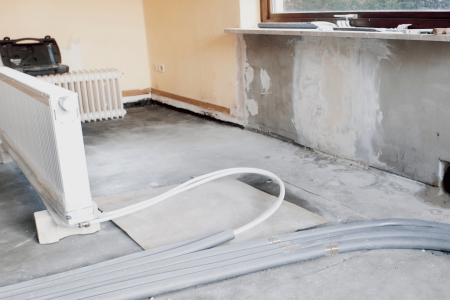Frustrated with rising heating bills? Then you might have considered a hydronic (or radiant) heating system. If so you’re making a smart choice, as they are far more energy efficient than their electric counterparts.
Not only are they more energy efficient, but hydronic systems are safer to use.
So ok, you might be convinced that a hydronic system is right for you. But there are many different types of hydronic heating systems. And each one comes with its own set of pros and cons, which makes it hard to decide which is best for you and your family.
To help you decide which hydronic heating system is right for you, we have written this guide. We not only explain the different radiant heating systems on the market, but also explain the pros and cons of various boilers you can use for hydronic heating.
So let’s get right to it!
Hydronic Heating Systems To Know Before You Buy
Following are the three hydronic heating systems you must know about:
Radiant Floor Heating
Radiant floor heating works by supplying heat directly to the floor or the ceiling of the house or the panels. Either water-heated tubing or electrically heated coils are responsible for carrying the heat from the source to your room.
But make sure you get a good radiant floor heating thermostat for maximum efficiency.
Benefits of Radiant Floor Heating
- Minimizes heat losses: Since radiant floor heating doesn’t have to rely on ducts for the transfer of heat, it eliminates heat losses and is more efficient than forced-convection air heating.
- Keeps allergies at bay: People with allergies prefer radiant floor heating over other types of hydronic heating systems. That is because it doesn’t rely on air for heat transfer and won’t introduce it to your room.
- Zero maintenance cost: You just have to put your radiant floor heater underground and forget it. And they are long-lasting, with many radiant heaters coming with a 30 year guarantee.
- More space: Radiant floor heating offers more space efficiency by not requiring you to install any radiators on your room’s walls. This gives you more freedom to renovate your room any way you want.
Cons of Radiant Floor Heating
- Steep installation cost: When you add the installation cost per square foot (usually between $10 and $20) with the cost of hiring a qualified electrician, you’re looking at the final installation bill touching the $500 mark.
- Can take a long time to heat up: One of the main questions I get is, how long does it take for radiant floors to heat up? While the answer varies depending on what kind of system you’re using, generally you should budget 30 to 60 minutes.
There is also radiant ceiling heat, although not as common. Take a look at this article to learn more about radiant ceiling heat.
Baseboard Heating
Baseboard heaters work on a familiar principle. They sit in the middle of your room, suck cold air from their surrounding and warm it by passing the air through a series of metal fins. These fins are hot due to the passage of electricity and they transmit the same heat to the air. The hot air will then rise up due to its low density before leaving the heater and warming up your room.
Benefits of Baseboard heating
- Quiet operation: Unlike their forced air counterparts, baseboard heaters work quietly. This makes them a must-have for bedrooms, as they won’t make any noise to disrupt your sleep.
- Easy to install: Unlike radiant floor heaters that force you to dig the ground, install the heater, and then lay an overlay on top, baseboard heaters are a cinch to install. So much so that you can install them on your own.
- Low installation cost: Since they can be installed by anyone with little to no technical experience, baseboard heaters won’t end up making a dent in your bank account.
- Easy to clean: Ever wondered how to clean baseboard heaters? Here’s the answer: just vacuum the whole thing. That is it. You don’t have to be a qualified mechanic to rid your unit’s interior of dust particles.
Cons of Baseboard heating
- Higher running cost: Worried about your monthly heating costs? Then you might want to pass on even the best hydronic baseboard heaters. They consume a lot of energy and will not be the most cost effective in terms of monthly bills.
Radiator
Also known as hot water heaters, radiators work on the principle of forced convection. A boiler or any other heat source heats water, which then ends up making its way to the radiator through pipes. The radiator then releases the water’s heat in the form of steam to warm up your room.
Benefits of Radiators
- Longer lasting heat: Ever opened your car’s bonnet a few hours after you parked your vehicle in your garage? You may have noticed some heat still coming out of the radiator. That’s because radiators retain heat for more extended periods.
- Easy to maintain: Radiators don’t need any ventilation source to work at their optimum level. Nor do they contain any fuels which you’d have to replace regularly. This makes them extremely easy to maintain.
Drawbacks of Radiators
- Pose a safety hazard: One of the most significant drawbacks of radiators is that they are super hot when in operation. And they pose a risk of starting a fire if the touch drapes or a couch.
Options For Hydronic Heating
Here are different options you can use for hydronic heating:
Tankless Water Heater
Tankless water heaters work by heating water passing through their pipes via an electric or gas source. They don’t have any storage tank for retaining water and deliver an on-demand supply of hot water. Some of them are capable of offering as much as 20 gallons per minute of hot water.
These units also occupy less space on the ground, have a longer lifespan and have lower running costs than their tank-carrying counterparts. However, one of the biggest complaints people have with tankless water heaters is inconsistent water temperatures.
| Pros | Cons |
|
|
Combi Boiler
Combi boilers combine a central heating boiler with a high-efficiency water heater. They are similar to tankless water heaters because they lack a water storage tank too. Instead, once you open a tap, they’d summon cold water, raise its temperature and send hot water through the pipes.
Hence the reason why they’re perfect for smaller homes and condos. The best combi boiler will work in situations when the storage space is low, as the absence of a cold-water storage tank means you can install them under the sink, on the wall or in similar smaller spaces.
| Pros | Cons |
|
|
Solar Water Heater
Solar water heaters use sunlight to heat water. Most of them deflect the thermal energy of the sunrays to water captured in a storage tank and raise its temperature. They are available in various types, including flat-plate collectors, batch collectors and evacuated tube collectors.
To transmit heat generated by solar panels to hydronic heating systems, you need two coils: the upper one will harvest solar energy, and the lower coil will transfer that energy to the hydronic heating loop in the form of heat.
This makes their installation a tad difficult for a beginner.
| Pros | Cons |
|
|
Heat Pump
Heat pumps work by extracting heat from the air outside of your room and then transmitting it to their inner coolant. This raises the temperature of the coolant and forces it to compress. That coolant is then transferred to the pump’s indoor unit, where the air is made to pass over the hot coolant.
As a result, the temperature of the air which is enters your room rises. That doesn’t mean that there are no downsides with hydronic heat pumps. Unless you can supply them with massive amounts of electricity, they cannot be used for slab or floor heating.
| Pros | Cons |
|
|
FAQs
Q: Which hydronic system is most efficient?
A: Radiant floor heaters are the most efficient. Mainly because the absence of any ductwork allows them to keep energy losses at a minimum. But also because of the fact that these units make the most of the energy supplied to them by ensuring uniform heat distribution.
But there is still some debate about a tankless water heater vs boiler for radiant heat which is worth looking into if you’re still undecided.
Q: Can you install hydronic heating yourself?
A: You can install hydronic heating equipment yourself as long as you have enough prior experience installing similar equipment. That and an installation manual specific to the unit you’re trying to install.
However, if you ask us, we suggest hiring an expert electrician. Many things could go wrong in the installation and you may end up damaging the equipment if you’re a novice.
Q: Can a hydronic system be retrofitted?
A: Yes, you can retrofit a hydronic system. However, it would be best if you didn’t try doing it on your own. Only a professional installer can retrofit a hydronic system. And they, too, will be able to do that only after they have assessed your home’s configuration and its pipework.
For example, assume for a moment that the professional has determined that the crawl space under your home is sufficient. They might then opt for installing PEX or polyethylene heating pipes under your home’s existing floor to insulate its walls or floors.
Conversely, if the crawl space isn’t sufficient, the installer won’t have any choice but to remove all floor coverings. The reason is that only then could they lay bare the joists from above, which is necessary to insulate your home’s walls and floors to prevent any heat for escaping.
Conclusion
So in summary there are three main types of hydronic heating systems. They include radiant floor heating systems, baseboard heating systems and radiators.
And here’s how you choose between the three.
Go for radiant floor heaters if you can tolerate paying more initially (in terms of installation cost and the cost of the unit) to enjoy better heat efficiency, decade-long durability and uniform heat transfer in the long run. That isn’t the case with the two remaining types of hydronic heating systems.
While baseboard heaters cost less up front and are extremely easy to install, they are a little more expensive month to month. Radiators, meanwhile, are even easier to get up and running. But they might not be the best bet for you if you’re looking to warm up a large room or house.
Whatever system you end up choosing, we hope you are at least more informed about what radiant heat is and its benefits.

Nick Lopresti is the founder of YourH2Home and a home improvement expert. He has years of experience writing about various home improvement topics, mostly as it pertains to water systems.
